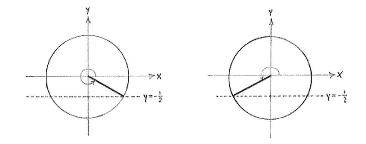Solution 4.4:1f
From Förberedande kurs i matematik 1
m (Lösning 4.4:1f moved to Solution 4.4:1f: Robot: moved page) |
|||
| Line 1: | Line 1: | ||
| - | {{ | + | We can translate the equation |
| - | < | + | <math>\sin v=-\frac{1}{2}</math> |
| - | {{ | + | to the problem of finding those angles in the unit circle which have a y-coordinate of |
| - | + | <math>-\frac{1}{2}</math>. If we compare this with the problem that we had in exercise a, where we looked for angles which satisfied | |
| + | <math>\sin v=+\frac{1}{2}</math>, then the situation is the same, except that the angles now lie under, rather than above, the | ||
| + | <math>x</math> | ||
| + | -axis, due to reflectional symmetry. | ||
[[Image:4_4_1_f.gif|center]] | [[Image:4_4_1_f.gif|center]] | ||
| + | |||
| + | Angle | ||
| + | <math>2\pi -\frac{\pi }{6}=\frac{11\pi }{6}</math> | ||
| + | Angle | ||
| + | <math>\pi +\frac{\pi }{6}=\frac{7\pi }{6}</math> | ||
| + | |||
| + | |||
| + | The two angles which satisfy | ||
| + | <math>\sin v=-\frac{1}{2}</math> | ||
| + | lie in the third and fourth quadrants and are | ||
| + | <math>v=2\pi -\frac{\pi }{6}=\frac{11\pi }{6}</math> | ||
| + | and | ||
| + | <math>v=\pi +\frac{\pi }{6}=\frac{7\pi }{6}</math> | ||
Revision as of 12:47, 30 September 2008
We can translate the equation \displaystyle \sin v=-\frac{1}{2} to the problem of finding those angles in the unit circle which have a y-coordinate of \displaystyle -\frac{1}{2}. If we compare this with the problem that we had in exercise a, where we looked for angles which satisfied \displaystyle \sin v=+\frac{1}{2}, then the situation is the same, except that the angles now lie under, rather than above, the \displaystyle x -axis, due to reflectional symmetry.
Angle \displaystyle 2\pi -\frac{\pi }{6}=\frac{11\pi }{6} Angle \displaystyle \pi +\frac{\pi }{6}=\frac{7\pi }{6}
The two angles which satisfy
\displaystyle \sin v=-\frac{1}{2}
lie in the third and fourth quadrants and are
\displaystyle v=2\pi -\frac{\pi }{6}=\frac{11\pi }{6}
and
\displaystyle v=\pi +\frac{\pi }{6}=\frac{7\pi }{6}

